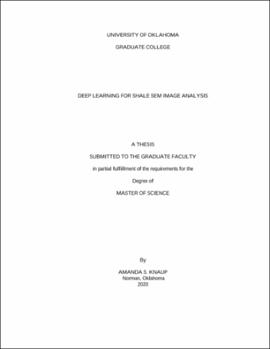| dc.description.abstract | The microstructure of unconventional reservoir rocks not only controls the storage and transport of hydrocarbons but also controls the mechanical properties of the shale. Scanning Electron Microscopy (SEM) has been valuable in understanding the microstructure of reservoir rocks. However, quantitative image analysis has been proven to be difficult. There are many limitations to image analysis that produce significant errors in determining areal porosity and organic matter content within shales. Current methods in building a suitable database for statistical analysis is time intensive, requires a trained technician, and cannot deal with the thousands of images already collected. This research evaluates the application of machine learning, more specifically Deep Learning, to reduce the time required to analyze SEM images from days, for a single large-area high-resolution MAPS area to a matter of seconds for a single image.
The objective of the initial work presented was to determine if there were significant microstructural differences between different formations that could be captured by computer software. In order to avoid acquiring large amounts of data required for training a network from scratch, the technique called transfer learning was applied to the pretrained convolutional neural network (CNN) AlexNet (Krizhevsky et al. 2017). This technique allows a user to re-teach the pre-trained network to focus on a new dataset than it was originally trained on. The dataset used comprised of 27,000 images (each 512x512 pixels) from 18 different formations spanning range of maturities. Results from this study generated probabilities of classification in association with different formations. Images with higher probability to other formations other than the intended label suggests there are microstructural similarities between formations. This work proved that convolutional neural networks can learn to identify features from the shale microstructure with an accuracy of 92%. As a result, this method was applied for classifying image quality with reasonable accuracy of 95% accuracy.
In addition to classification, CNNs can be applied to individual pixels within an image for classification. This is known as image segmentation. The focus in this topic is the identification and quantification of discrete objects such as pores, grains, organics, etc. applied directly to SEM images. When the model was applied to a large-area, high resolution maps with a large enough representative area (REA), it can provide representative and accurate results of area porosity and organic matter content (OM), consistent with lab measured porosity and TOC values. Accuracy of segmentation range from 92-99% for intersection over union metric (IoU) when classifying pore, OM and mineral content. Direct inspection of the images when compared to data generated using the Ilastik software proved to surpass the random forest method by more accurately defining boundaries between labels. The model was trained using Woodford images but was able to be successfully applied to images from other formations such as the Marcellus, Vaca Muerta, and Eagle Ford shales in addition to the Osage formation in the STACK play. This method was then expanded to identify carbonates, silicates, and other heavy minerals in addition to pore and organics. A sensitivity study was done in order to determine the best model. The sensitivity study was done to determine whether deeper or shallower models performed better with the data, more or less convolutional layers in the model, or a narrower or wider model performed better with the data, more or less filers per convolutional layer. This research shows that applications of CNNs to shales can quickly and accurately provide results in identifying similar formations in addition to features of interest. | en_US |

